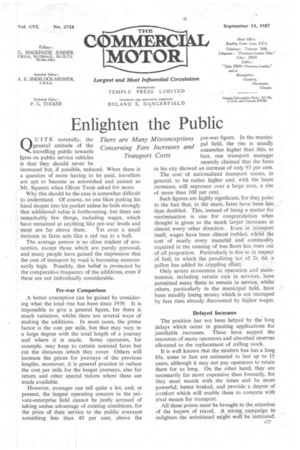Enlighten the Public
Page 27

If you've noticed an error in this article please click here to report it so we can fix it.
QUITE naturally, the general attitude of the travelling public towards fires on public service vehicles is that they should never be increased but, if possible, reduced. When there is a question of more having to be paid, travellers are apt to become as astonished and pained as Mr. Squeers when Oliver Twist asked for more.
Why this should be the case is somewhat difficult to understand. Of course, no one likes putting his hand deeper into his pocket unless he feels strongly that additional value is forthcoming, but there are remarkably few things, including wages, which have remained at anything like pre-war levels and most are far above them. Yet even a small increase in fares acts like a red rag to a bull.
The average person is no close student of economics, except those which are purely personal, and many people have gained the impression that the cost of transport by road is becoming unnecessarily high. Possibly, this belief is promoted by the comparative frequency of the additions, even if these are not individually considerable.
Pre-war Comparison A better conception can be gained by considering what the total rise has been since 1939. It is impossible to give a general figure, for there is much variation, whilst there are several ways of making the additions. In most cases, the prime factor is the cost per mile, but that may vary to a large degree with the total length of a journey and where it is made. Some operators, for example, may keep to certain nominal fares but cut the distances .which they cover. Others will increase the prices for journeys of the previous lengths, moreover, it is general practice to reduce the cost per mile for the longer journeys, also for return and other special tickets where these are made available.
However, averages can tell quite a lot, and, at present, the largest operating concern in the private-enterprise field cannot be justly accused of taking undue advantage of existing conditions, for the price of their service to the public averages something less than 40 per cent. above the pre-war figure. In the munici. pal field, the rise is usually somewhat higher than this, in fact, one transport manager recently claimed that the fares in his city showed an increase of only 93 per cent. The cost of nationalized transport seems, in general, to be rather higher and, with the latest increases, will represent over a large area, a rise of more than 100 per cent.
Such figures are highly significant,--for they point to the fact that, in the main, fares have been less than doubled. This, instead of being a matter for recrimination is one for congratulation when thought is given to the much larger inCreases in almost every other direction.. Even in transport itself, wages have been almost trebled, 'whilst the cost of nearly every material and commodity required in the running of bus fleets has risen ()tit of all proportion. Particularly is this so in respect of fuel, to which the penalizing taX. of 2s. 6d a gallon has added its crippling elTect.
Only severe economies in operation ,and maintenance, including certain cuts in services, have permitted many fleets to remain in service, whilst others, particularly in the municipal field, have been steadily losing money which is not recouped by fare rises already discounted by higher wages.
Delayed Increases The position has not been helped by the long delays which occur in granting applications for justifiable increases. These have sapped the resources of many operators and absorbed reserves allocated to the replacement of rolling stock.
It is well known that the Modern bus has a long life, some in fact are estimated to last up to 15 years, although it may not pay operators to retain them for so long. On the other hand, they are necessarily far more expensive than formerly, for they must march with the times and be more powerful, better braked, and provide a degree of comfort which will enable them to compete with rival means for transport.
. All these points must be brought to the attention of the buyers of travel. A strong_ campaign to enlighten the uninitiated might well be instituted. "A2.5




























































































